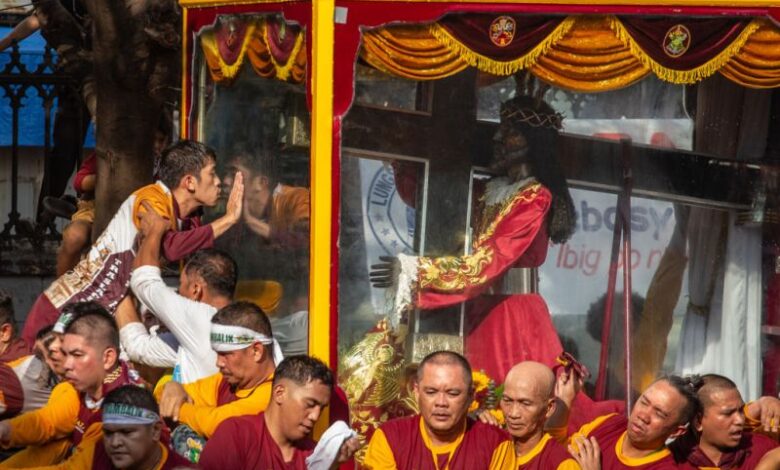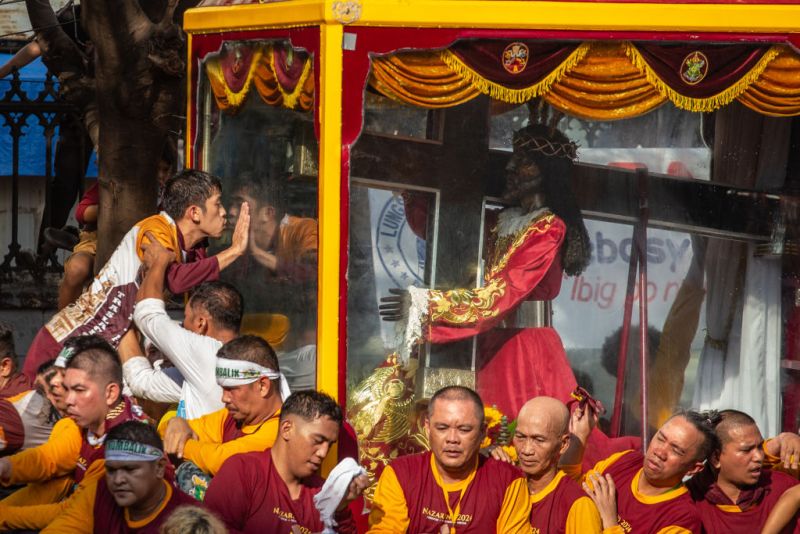Black Nazarene procession in the Philippines draws millions after returning from COVID

 A Catholic devotee kisses the glass cover of the Black Nazarene statue during the annual procession for the feast of the Black Nazarene in Manila, Philippines, on Jan. 9, 2024. Hundreds of thousands of Catholic faithful swarmed a historic statue of Jesus Christ as it was pulled through the streets of the Philippine capital in one of the world’s biggest displays of religious devotion. / Credit: EARVIN PERIAS/AFP via Getty Images
A Catholic devotee kisses the glass cover of the Black Nazarene statue during the annual procession for the feast of the Black Nazarene in Manila, Philippines, on Jan. 9, 2024. Hundreds of thousands of Catholic faithful swarmed a historic statue of Jesus Christ as it was pulled through the streets of the Philippine capital in one of the world’s biggest displays of religious devotion. / Credit: EARVIN PERIAS/AFP via Getty Images CNA Staff, Jan 9, 2024 / 15:00 pm (CNA).
The Black Nazarene procession in the Philippines, one of the largest religious devotions in the world, returned this year to its traditional size for the first time since the beginning of the COVID-19 pandemic, attracting millions of devotees.
The procession, known locally as “Traslacion,” sees devotees carry across Manila a replica of a famous life-size statue of Jesus carrying a black wooden cross. Taking place each year in January, this year’s event marked a return to the traditional procession after three years of drastic downsizing due to the threat of COVID-19.

In 2020, 2021, and 2022 the procession was essentially canceled entirely. In 2023, an estimated 103,277 faithful participated, far fewer than in past years.
This year, as in years before the pandemic, millions of mostly barefoot devotees turned out along the procession route, hoping to touch the statue and obtain a miracle or healing. The Philippines is the only country in Asia with a Catholic majority, with over 80% of the population belonging to the Church.
The image of Jesus used in the procession is believed to have been brought from Mexico to Filipino shores in 1606 by missionaries of the Order of Augustinian Recollects. The life-size statue of Jesus is today enshrined in the famous minor basilica popularly known as the Quiapo Church, located in the Archdiocese of Manila. First enshrined at St. John the Baptist Church in Luneta, the image was transferred to Quiapo in 1868.

An early morning estimate Jan. 9 by police put the crowd at more than 830,000 people, which later swelled to 6.5 million along the procession’s 3.7-mile route, according to an official of the Quiapo Church cited by Filipino news source Rappler.
This year, the icon was placed in a glass case for the first time, and participants were banned from getting onto the float as they have in previous years, though many ignored the directive, UCA News, a Catholic Asian news site, reported.
Rappler reported that the procession, which lasted 15 hours, was generally peaceful, although the Philippine Red Cross said hundreds needed medical attention due to heat stroke and injuries caused by the crowds.
The original statue has survived fires that destroyed the church twice, two earthquakes, the floods of numerous typhoons, and bombings during World War II. Quiapo Church receives thousands of Catholics every day for Mass and confession.

The procession, according to Monsignor Jose Clemente Ignacio, formerly the rector of Quiapo Church, commemorates “the transfer of the image from Luneta to Quiapo, when we first received the statue in 1868.”
In addition, he said, “‘Traslacion’ means the transfer of the Image of Black Nazarene. In a way it is imitating the Calvary experience: the sacrifice and suffering that Our Lord endured for our salvation like when Jesus was walking barefoot, carrying the cross to Mount Calvary.”
Authorities were reportedly on high alert in the Philippines after at least four people were killed and 54 injured in a Dec. 3, 2023, bombing at a Catholic Mass in the predominantly Muslim city of Marawi.
The Islamic State claimed responsibility for the bombing in a telegram message on Dec. 3, a claim that the country’s military said it was working to verify.





